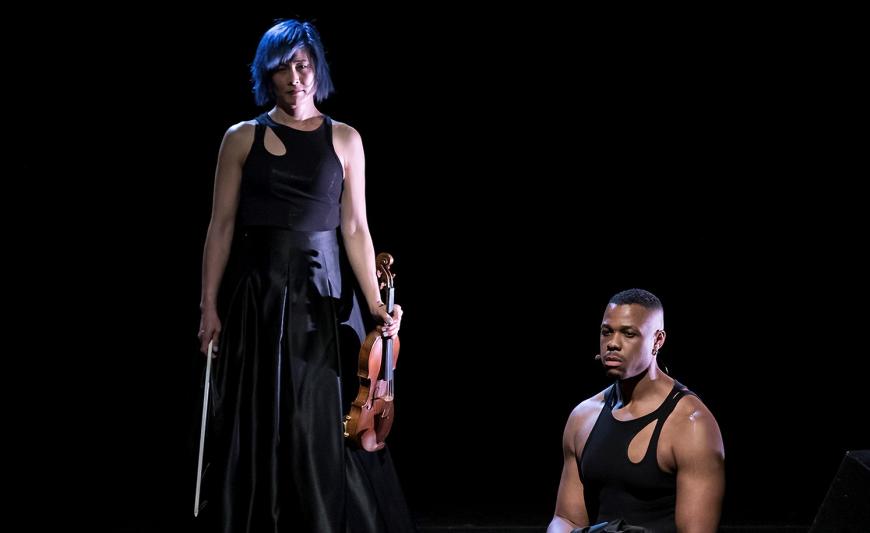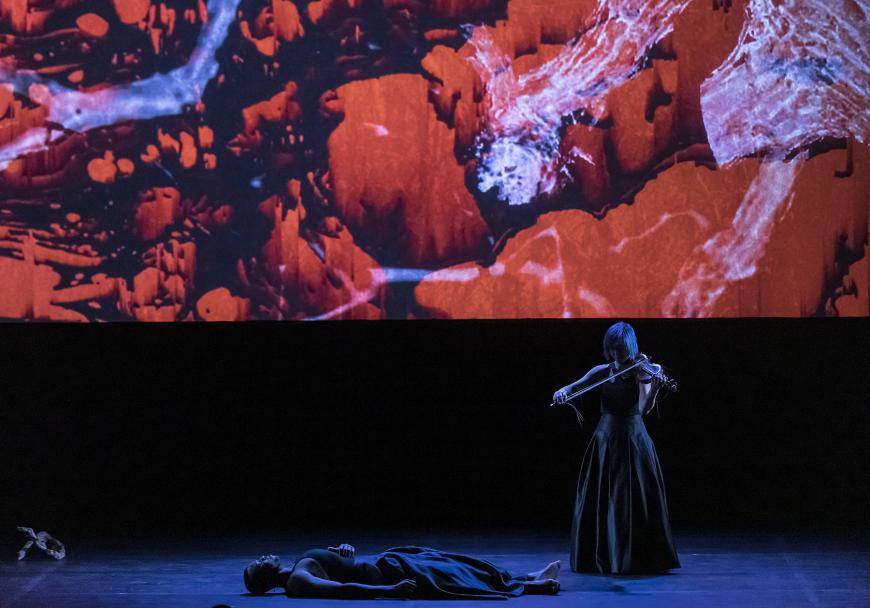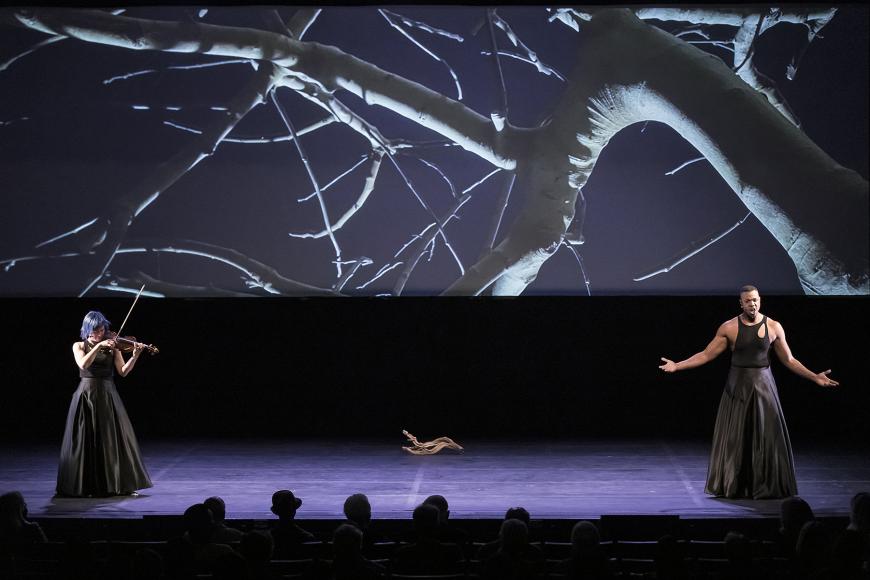
According to the original plan, the thematically loaded multimedia project Everything Rises, the innovative brainchild of co-creators violinist Jennifer Koh and bass-baritone Davóne Tines, would have had its world premiere in 2020. COVID put the kibosh on that best-laid plan. Between then and the work’s world premiere, at UC Santa Barbara’s Campbell Hall on Tuesday night, April 12, much more has risen in terms of worldly affairs. Nobody could have predicted how inflamed the issues of race — the Black Lives Matter movement, an uptick in anti-Asian sentiments and hate crimes — would become in the past two years.
The externally imposed hiatus did afford extra time for creative gestation, though. Five years into this project’s life, Koh and Tines have pieced together an unusually autobiographical and genre-busting music-theater work. At the core are matters close to the heart of these artists, but with themes broadening into larger social and cultural discussions, in pointed but also poetic ways.
Both Koh and Tines share the experience of being artists of color in a white-dominated and often white-dictated Eurocentric classical domain, who are also actively engaged in the line of contemporary music-molding. In the early song “A Story of the Moth,” Tines openly addresses the stresses of working in a whitened artistic world: “I was the moth … lured by your flame / I hated myself for needing you / dear white people / money, access, and fame.” Of course, the Santa Barbara audience was largely white, triggering a certain guilt by association, but the ultimate goal of the piece is to raise awareness and unearth buried, repressed truths.

Everything Rises boasts a diversified musical score by composer and librettist Ken Ueno with aspects of video, dance, and between-the-lines x factors organized by director Alexander Gedeon. Where does Everything Rises fit within the contemporary artistic canon? No tidy answer is forthcoming. The piece emerges as a fascinating outlier, as music theater pieces go. Rather than a linear or narrative construct, the hour-long work unfolds as a composited conceptual mosaic, delving into the creators’ personal lives but extending both sociohistorically outward and spiritually inward.
Musically, the piece ranges from minimal lyricism to dissonant/expressionistic outbursts for Koh and a wide spectrum of materials capitalizing on the sonorousness and flexibility of Tines’s voice. Ueno’s score occasionally gets bogged down when pre-taped synthesizer patchworks distract from the analog purity of the violin and voice parts so captivatingly realized from the principals. Real-time human expression wins out.
Among the pieces in this reimagined and deconstructed song cycle are a plugged-in post-gospel number, cowritten by Tines, “Amen.” Toward the finale, the spotlight turns on the anti-racist anthem “Strange Fruit,” so hauntingly immortalized by Billie Holiday but here revitalized in a newly arranged, almost Cubist version. (In a “talkback” session after the performance, Tines said that “it felt like a no-brainer” to include the song now, given recent blows to Black life and the widespread indignation and protest in response).

Hana S. Kim’s projection and design strategy is aptly loose and malleable, in sync with the work’s general expressive terrain. Facets of gritty historical realities, from the time of the Korean War to shards of archival civil rights imagery in America, meld with and melt into more abstract visuals. Reality interlaces with rough impressionistic visual meshes and instances of multiple-duty tree symbolism — tree as lynching site and as archetypal framework for humanity, ancestry, and artistic lineages.
“Heavy is the tree,” Tines sings in the song “Parallel Histories,” “traumas / woven into our skin.”
Trauma, in this case, also comes down through the generations, in the tales of powerful matriarchs in their respective families. Their taped narration makes them important figures and “performers” in the piece, remote but residually powerful. Tines’s grandmother Alma Lee Gibbs Tines carried the pain of racist oppression in her day and relays lingering echoes of slavery in the family tree. Koh’s mother Gertrude Soonja Lee Koh speaks of nightmarish memories of the Korean War, before emigrating to the U.S. and experiencing that assimilation and alienation process.
What might seem, on paper and in concept, to be largely forbidding territory is given various shades of dark and light in the finished form of Everything Rises. Creative energies and visceral sight-sound connections keep the sensory element busy and engaged, even as we unpack the painful implications of the thematic material. The sheer expressive power of Koh and Tines is enough, even before other factors are considered, to lure us deeply in.
By the work’s end, the pair have eased into a more relaxed and resolved posture, sitting at the stage’s edge before an audience with the house lights now on. Such an effect helps strip away theatrical detachment. The finale, “Better Angels,” acknowledges the horrors of history and present reality while making a gesture of informed coming-to-terms in such passages as this one elegantly intoned by Tines: “weep / for those / who sleep / the sweep / of history / is long / an arc that / bends / towards / the light.”
It’s not a happy ending, but a hopeful one.



